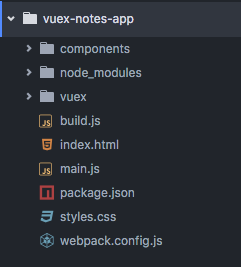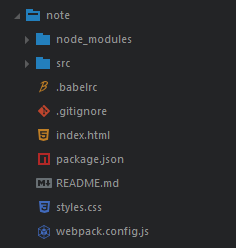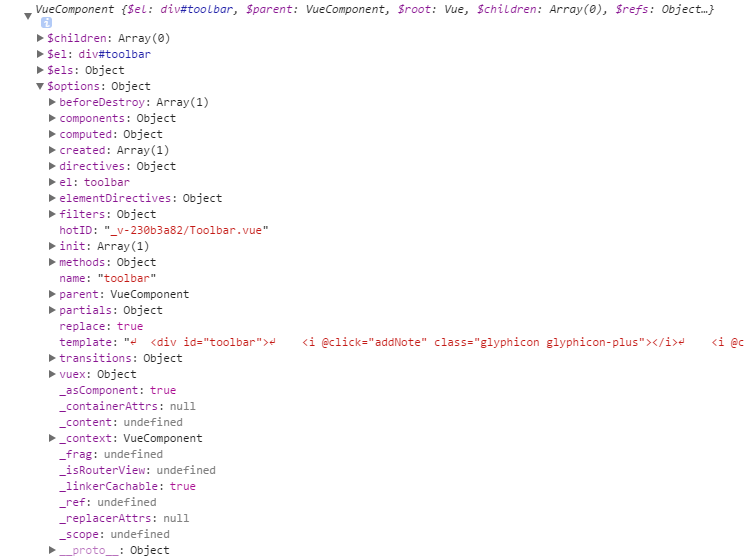您好,登錄后才能下訂單哦!
您好,登錄后才能下訂單哦!
小編給大家分享一下如何使用vuejs2.0+vuex 2.0構建記事本應用,相信大部分人都還不怎么了解,因此分享這篇文章給大家參考一下,希望大家閱讀完這篇文章后大有收獲,下面讓我們一起去了解一下吧!
開始吧
以下是 notes-vuex-app 的源文件目錄:

在使用 vue 2 重寫這個 app 之前,我在想能不能不改變文件目錄結構以及配置位置呢?就是用比較生硬的方式重寫,或者說單純的語法修改。事實是可行的,否則我就不會寫這篇文章了。然而面對的問題非常多,但卻因此深入的理解了 vue 以及 vuex。最大的問題是 webpack 的構建,如果使用 webpack 2.0+的話,坑比較多。本人是菜鳥,所以最終選擇了 vue-cli 提供的兩個 webpack 的模板,分別是 webpack-simple 和 webpack,我先使用 webpack-simple,它和原 app 的結構基本吻合。目錄如下:

使用 vue-cli 生成基本目錄之后,再安裝 vuex2 。
main.js 的小改動
原示例 main.js 如下所示,但運行出錯了,主要是 Vue 2 的根實例渲染稍有變化
import Vue from 'vue'
import store from './vuex/store'
import App from './components/App.vue'
new Vue({
store, // 注入到所有子組件
el: 'body',
components: { App }
})改正之后:
import Vue from 'vue'
import store from './vuex/store'
import App from './components/App.vue'
new Vue({
store, // inject store to all children
el: '#app',
template: '<App/>',
components: { App }
})或者
import Vue from 'vue'
import store from './vuex/store'
import App from './components/App.vue'
new Vue({
store, // inject store to all children
el: '#app',
render: h => h(App)
})vuex 2 的變化
這個應用改寫的主要問題集中在 vuex 2 的變化上,這些變化確實會讓人感到凌亂,我無數次抓耳撓腮的罵娘。不過通過官方給出的示例也可以看出一些端倪。
首先是 action.js,只需注意一點,所有的 dispatch 都要改成 commit。
export const addNote = ({ commit }) => {
commit('ADD_NOTE')
}
export const editNote = ({ commit }, e) => {
commit('EDIT_NOTE', e.target.value)
}
export const deleteNote = ({ commit }) => {
commit('DELETE_NOTE')
}
export const updateActiveNote = ({ commit }, note) => {
commit('SET_ACTIVE_NOTE', note)
}
export const toggleFavorite = ({ commit }) => {
commit('TOGGLE_FAVORITE')
}store.js 變化也不大,但是要注意幾個地方:
import Vue from 'vue'
import Vuex from 'vuex'
import * as actions from './actions'
Vue.use(Vuex)
const state = {
notes: [],
activeNote: {}
}
const mutations = {
ADD_NOTE (state) {
const newNote = {
text: 'New note',
favorite: false
}
state.notes.push(newNote)
state.activeNote = newNote
},
EDIT_NOTE (state, text) {
state.activeNote.text = text
},
DELETE_NOTE (state) {
state.notes.splice(state.notes.indexOf(state.activeNote),1)
state.activeNote = state.notes[0] || {}
},
TOGGLE_FAVORITE (state) {
state.activeNote.favorite = !state.activeNote.favorite
},
SET_ACTIVE_NOTE (state, note) {
state.activeNote = note
}
}
const getters = {
notes: state => state.notes,
activeNote: state => state.activeNote,
activeNoteText: state => state.activeNote.text
}
export default new Vuex.Store({
state,
mutations,
actions,
getters
})原示例文件中沒有將 getters 寫到 store.js 中,而是直接在組件中定義的。為了更清晰,我仿照官方示例也提取出來寫在了 store.js 中,這樣在組件中調用時比較方便。其次也引入了 action.js,并作為 actions 對象傳遞給 Vuex.store(),這算是 vuex 的標準寫法吧,對于后面在組件中調用比較有利。
其中要注意 DELETE_NOTE (state){} 這個方法,原示例使用了 vue1 提供的 remove 方法,但是 vue2 中去掉了這個方法。仔細想想就會明白,這個函數的作用就是刪除 notes 數組中的元素。可以使用原生的 splice 方法。如果 JS 基礎扎實的話,這里應該很好理解,沒有什么大問題。其次相比原示例,添加一個刪除后操作的判斷。
我之前一直不太理解 flux 的概念,感覺像是新東西,完全不知道它的目的及作用。換成 Vuex,還是有點稀里糊涂。但是通過修改這個示例,基本算是開竅了。這些東西本身并沒有玄機奧妙,想一想,如果我們不用框架,而是自己手寫一個 todoMVC 時要怎么做?應該也是這樣的思路,定義一個 notes 數組變量以及 activeNote 的變量。然后在創建一些改變狀態的方法。我在面試中遇到過一個情況,面試官反復問我為什么需要使用框架,用 jQuery 不是也可以實現嗎?這樣說確實沒錯,用比較原始的方法當然可以做,只是代碼結構會冗余或者凌亂,缺少小而美的特點。框架以及設計模式對代碼做了整合封裝,對于一個 CURD 應用比較友好,實現起來更方便更簡單。我對于 Vuex 的理解就是,它是一個對象,封裝了與狀態相關的方法和屬性。而所謂的狀態就是點擊、按鍵等操作之后的變化。
組件中使用 vuex
先看一下 Toolbar.vue 這個組件。修改后的代碼如下:
<template>
<div id="toolbar">
<i @click="addNote" class="glyphicon glyphicon-plus"></i>
<i @click="toggleFavorite"
class="glyphicon glyphicon-star"
:class="{starred: activeNote.favorite}"></i>
<i @click="deleteNote" class="glyphicon glyphicon-remove"></i>
</div>
</template>
<script>
import { mapGetters, mapActions } from 'vuex'
export default {
computed: mapGetters([
'activeNote'
]),
methods: {
...mapActions([
'addNote',
'deleteNote',
'toggleFavorite'
])
}
}
</script>通過和原示例代碼對比,這里的區別一目了然。我通過在控制臺打印 Vue 實例,折騰很長時間才大體明白怎么回事。vuex 1 在組件中使用時會直接將 getters 以及 actions 掛到 vuex 這個屬性上,沒有提供 mapGetters 及 mapActions 等一些方法。而 vuex2 使用 mapGetters 及 mapActions 等一些方法將 actions 的方法掛到 Vue 實例上。總的來說,都是把 actions 的方法掛到 Vue 實例上。我們從這個層面上談談 Vue 實例,Vue 2 的變化就是其屬性的變化。比如 Vue1 中在 methods 中添加的方法可以在 vue 實例的 $options 屬性中查看,而 vue2 中這些方法可以直接在第一級屬性中查找或者在 $options 屬性下的原型方法中 __proto__ 尋找。在 vue1 中可以查看 vuex 這個屬性,但是 vue2 中移除了。至于其它的不同,大家可以自己對比,通過這種方式,可以深入理解 vue 的設計思想。
下圖是 Vue1 實例截圖:

ES5 實現擴展運算符
假設其它組件都以這種方式改好了,就在我們滿心歡喜地運行示例時,又報錯了。問題出在擴展運算符 ... 上,webpack-simple 這個模板無法解析 ES6 的 ...。為此,我又折騰了很久,想試著修改 webpack 的配置文件,但改動太大。我妥協了,決定拋棄擴展運算符,手寫這個方法。當然如果使用 webpack 的模板就沒有問題,這個比較簡單,我們最后再說。
手寫擴展運算符 ... 之前,我們先看一下 mapActions 這個方法。對于 mapGetters 以及 mapActions 這兩個函數,最簡單的理解辦法就是查看 vuex 的源碼,最終返回的是一個對象。也就是根據需要獲取 store.js 中 actions 對象的某些方法。然后通過擴展運算符把返回的對象拆開然后掛到 Vue 實例上。舉例來說(以下只是擴展運算符的用法之一,別的用法可以參考其它的文章):
var obj = {
a: 1,
b: 2,
}
var methods = {
...obj
}
// console.log(methods)
{
a: 1,
b: 2
}明白擴展運算符的用法之后就好辦了。為了簡單一點,我直接使用 babel 官網的在線解析器,查看擴展運算符的 ES5 寫法。
// ES5 實現擴展運算符...
var _extends = Object.assign || function(target) {
for (var i = 1; i < arguments.length; i++) {
var source = arguments[i];
for (var key in source) {
if (Object.prototype.hasOwnProperty.call(source, key)) {
target[key] = source[key];
}
}
}
return target;
};完整的 Toolbar.vue 組件代碼如下:
<template>
<div id="toolbar">
<i @click="addNote" class="glyphicon glyphicon-plus"></i>
<i @click="toggleFavorite"
class="glyphicon glyphicon-star"
:class="{starred: activeNote.favorite}"></i>
<i @click="deleteNote" class="glyphicon glyphicon-remove"></i>
<i @click="_test" class="glyphicon glyphicon-remove"></i>
</div>
</template>
<script>
import { mapGetters, mapActions } from 'vuex'
// ES5 實現擴展運算符...
var _extends = Object.assign || function(target) {
for (var i = 1; i < arguments.length; i++) {
var source = arguments[i];
for (var key in source) {
if (Object.prototype.hasOwnProperty.call(source, key)) {
target[key] = source[key];
}
}
}
return target;
};
var actions = mapActions([
'addNote',
'deleteNote',
'toggleFavorite'
]);
var methodsObj = _extends({},actions)
export default {
computed: mapGetters([
'activeNote'
]),
methods:methodsObj
}
</script>其余兩個子組件類似,相信大家已經明白了我的思路,具體代碼如下:
NotesList.vue
<template>
<div id="notes-list">
<div id="list-header">
<h3>Notes | coligo</h3>
<div class="btn-group btn-group-justified" role="group">
<!-- All Notes button -->
<div class="btn-group" role="group">
<button type="button" class="btn btn-default"
@click="show = 'all'"
:class="{active: show === 'all'}">
All Notes
</button>
</div>
<!-- Favorites Button -->
<div class="btn-group" role="group">
<button type="button" class="btn btn-default"
@click="show = 'favorites'"
:class="{active: show === 'favorites'}">
Favorites
</button>
</div>
</div>
</div>
<!-- render notes in a list -->
<div class="container">
<div class="list-group">
<a v-for="note in filteredNotes"
class="list-group-item" href="#" rel="external nofollow"
:class="{active: activeNote === note}"
@click="updateActiveNote(note)">
<h5 class="list-group-item-heading">
{{note.text.trim().substring(0, 30)}}
</h5>
</a>
</div>
</div>
</div>
</template>
<script>
import { mapGetters, mapActions } from 'vuex'
// ES5 實現擴展運算符...
var _extends = Object.assign || function(target) {
for (var i = 1; i < arguments.length; i++) {
var source = arguments[i];
for (var key in source) {
if (Object.prototype.hasOwnProperty.call(source, key)) {
target[key] = source[key];
}
}
}
return target;
};
var getters = mapGetters([
'activeNote'
]);
var filters = {
filteredNotes: function () {
if (this.show === 'all'){
return this.$store.state.notes
} else if (this.show === 'favorites') {
return this.$store.state.notes.filter(note => note.favorite)
}
}
}
var actions = mapActions(['updateActiveNote'])
var computedObj = _extends({},getters,filters);
var methodsObj = _extends({},actions);
export default {
data () {
return {
show: 'all'
}
},
computed:computedObj,
methods:methodsObj
}
</script>Editor.vue
<template>
<div id="note-editor">
<textarea
:value="activeNoteText"
@input="editNote"
class="form-control">
</textarea>
</div>
</template>
<script>
import { mapGetters, mapActions } from 'vuex'
export default {
computed:mapGetters(['activeNoteText']),
methods:mapActions(['editNote'])
}
</script>Webpack 模板
直接使用 vue-cli 的 webpack 模板就會簡單很多,可以直接解析擴展運算符,代碼也會比較簡潔。
以上是“如何使用vuejs2.0+vuex 2.0構建記事本應用”這篇文章的所有內容,感謝各位的閱讀!相信大家都有了一定的了解,希望分享的內容對大家有所幫助,如果還想學習更多知識,歡迎關注億速云行業資訊頻道!
免責聲明:本站發布的內容(圖片、視頻和文字)以原創、轉載和分享為主,文章觀點不代表本網站立場,如果涉及侵權請聯系站長郵箱:is@yisu.com進行舉報,并提供相關證據,一經查實,將立刻刪除涉嫌侵權內容。